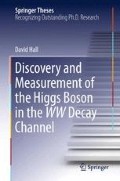Abstract
Although the search for the Higgs boson is motivated by the electroweak interaction, a detailed knowledge of quantum chromodynamics (QCD) is required to make precise predictions at a hadron collider such as the LHC.
Access this chapter
Tax calculation will be finalised at checkout
Purchases are for personal use only
Notes
- 1.
A mathematically rigorous proof of confinement is one of seven Millennium Prize Problems of the Clay Mathematics Institute, with a bounty of $1,000,000.
References
R.K. Ellis, W.J. Stirling, B.R. Webber, QCD and Collider Physics (Cambridge University Press, Cambridge, 1996)
I.J.R. Aitchison, A.J.G. Hey, Gauge Theories in Particle Physics, 3rd edn. (Taylor and Francis, Abingdon, 2003)
K.G. Wilson, Confinement of quarks. Phys. Rev. D 10, 2445 (1974)
D.J. Gross, F. Wilczek, Ultraviolet behavior of non-Abelian Gauge theories. Phys. Rev. Lett. 30, 1343 (1973)
H.D. Politzer, Reliable perturbative results for strong interactions? Phys. Rev. Lett. 30, 1346 (1973)
Particle Data Group, Review of particle physics. Phys. Rev. D 86, 010001 (2012), and 2013 partial update for the 2014 ed
J.C. Collins, D.E. Soper, Parton distribution and decay functions. Nucl. Phys. B 194, 445 (1982)
V.N. Gribov, L.N. Lipatov, Deep inelastic \(ep\) scattering in perturbation theory. Sov. J. Nucl. Phys. 15, 438 (1972)
G. Altarelli, G. Parisi, Asymptotic freedom in parton language. Nucl. Phys. B 126, 298 (1977)
Y. L. Dokshitser, Calculation of structure functions of deep inelastic scattering and \(e^{+}e^{-}\) annihilation by perturbative theory in quantum chromodynamics. Sov. Phys.-JETP 46, 641 (1977)
A.D. Martin, W.J. Stirling, R.S. Thorne, G. Watt, Parton distributions for the LHC. Eur. Phys. J. C 63, 189 (2009), arXiv:0901.0002 [hep-ph]
A. Buckley et al., General-purpose event generators for LHC physics. Phys. Rep. 504, 145 (2011), arXiv:1101.2599 [hep-ph]
S. Höche, Matching to matrix elements, in MCnet-LPCC Summer School on Monte Carlo Event Generators for LHC, Geneva (2012)
M.R. Whalley, D. Bourilkov, R.C. Group, The Les Houches accord PDFs (LHAPDF) and LHAGLUE, in HERA and the LHC, Hamburg (2005), arXiv:hep-ph/0508110
H.-L. Lai et al., New parton distributions for collider physics. Phys. Rev. D 82, 074024 (2010), arXiv:1007.2241 [hep-ph]
R.D. Ball et al., Parton distributions with LHC data. Nucl. Phys. B 867, 244 (2013), arXiv:1207.1303 [hep-ph]
G. Corcella et al., HERWIG 6: an event generator for hadron emission reactions with interfering gluons (including supersymmetric processes). JHEP 0101, 010 (2001), arXiv:hep-ph/0210213
M. Bähr et al., Herwig++ physics and manual. Eur. Phys. J. C 58, 639 (2008), arXiv:0803.0883 [hep-ph]
J.M. Butterworth, J.R. Forshaw, M.H. Seymour, Multiparton interactions in photoproduction at HERA. Z. Phys. C 72, 637 (1996), arXiv:hep-ph/9601371
T. Sjöstrand, S. Mrenna, P. Skands, PYTHIA 6.4 physics and manual. JHEP 0605, 026 (2006), arXiv:hep-ph/0603175
T. Sjöstrand, S. Mrenna, P. Skands, A brief introduction to PYTHIA 8.1. Comput. Phys. Commun. 178, 852 (2008), arXiv:0710.3820[hep-ph]
T. Gleisberg et al., Event generation with SHERPA 1.1. JHEP 0902, 007 (2009), arXiv:0811.4622 [hep-ph]
S. Catani, F. Krauss, R. Kuhn, B.R. Webber, QCD matrix elements + parton showers. JHEP 0111, 063 (2001), arXiv:hep-ph/0109231
L. Lonnblad, Correcting the color-dipole cascade model with fixed order matrix elements. JHEP 0205, 046 (2002), arXiv:hep-ph/0112284
S. Hoeche et al., Matching parton showers and matrix elements (2006), arXiv:hep-ph/0602031
M.L. Mangano, M. Moretti, F. Piccinini, R. Pittau, A.D. Polosa, ALPGEN, a generator for hard multiparton processes in hadronic collisions. JHEP 0307, 001 (2003), arXiv:hep-ph/0206293
J. Alwall, M. Herquet, F. Maltoni, O. Mattelaer, T. Stelzer, MadGraph 5: going beyond. JHEP 1106, 128 (2011), arXiv:1106.0522 [hep-ph]
P. Nason, B. Webber, Next-to-leading-order event generators. Ann. Rev. Nucl. Part. Sci. 62, 187 (2012), arXiv:1202.1251 [hep-ph]
S. Frixione, B.R. Webber, Matching NLO QCD computations and parton shower simulations. JHEP 0206, 029 (2002), arXiv:hep-ph/0204244
S. Frixione, F. Stoeckli, P. Torrielli, B.R. Webber, NLO QCD corrections in Herwig++ with MC@NLO. JHEP 1101, 053 (2011), arXiv:1010.0568 [hep-ph]
V. Hirschi et al., Automation of one-loop QCD corrections. JHEP 1105, 044 (2011), arXiv:1103.0621 [hep-ph]
P. Torrielli, S. Frixione, Matching NLO QCD computations with PYTHIA using MC@NLO. JHEP 1004, 110 (2010), arXiv:1002.4293 [hep-ph]
P. Nason, A new method for combining NLO QCD with shower Monte Carlo algorithms. JHEP 0411, 040 (2004), arXiv:hep-ph/0409146
S. Frixione, P. Nason, C. Oleari, Matching NLO QCD computations with parton shower simulations: the POWHEG method. JHEP 0711, 070 (2007), arXiv:0709.2092 [hep-ph]
S. Alioli, P. Nason, C. Oleari, E. Re, A general framework for implementing NLO calculations in shower Monte Carlo programs: the POWHEG BOX. JHEP 1006, 043 (2010), arXiv:1002.2581 [hep-ph]
S. Agostinelli et al., Geant4—a simulation toolkit. Nucl. Instrum. Methods A506, 250 (2003)
ATLAS Collaboration, The ATLAS simulation infrastructure, Eur. Phys. J. C 70, 823 (2010), arXiv:1005.4568[physics.ins-det]
ATLAS Collaboration, The simulation principle and performance of the ATLAS fast calorimeter simulation FastCaloSim, ATL-PHYS-PUB-2010-013 (2010)
ATLAS Collaboration, Summary of ATLAS Pythia 8 tunes. ATL-PHYS-PUB-2012-003 (2012)
ATLAS Collaboration, Example ATLAS tunes of Pythia8, Pythia6 and Powheg to an observable sensitive to \(Z\) boson transverse momentum. ATL-PHYS-PUB-2013-017 (2013)
G.P. Salam, Towards jetography. Eur. Phys. J. C 67, 637 (2010), arXiv:0906.1833 [hep-ph]
M. Cacciari, G.P. Salam, G. Soyez, FastJet user manual. Eur. Phys. J. C 72, 1896 (2012), arXiv:1111.6097 [hep-ph]
M. Cacciari, G.P. Salam, G. Soyez, The anti-\(k_t\) jet clustering algorithm. JHEP 0804, 063 (2008), arXiv:0802.1189 [hep-ph]
Author information
Authors and Affiliations
Corresponding author
Rights and permissions
Copyright information
© 2015 Springer International Publishing Switzerland
About this chapter
Cite this chapter
Hall, D. (2015). Computational Techniques for the LHC. In: Discovery and Measurement of the Higgs Boson in the WW Decay Channel. Springer Theses. Springer, Cham. https://doi.org/10.1007/978-3-319-19989-4_2
Download citation
DOI: https://doi.org/10.1007/978-3-319-19989-4_2
Published:
Publisher Name: Springer, Cham
Print ISBN: 978-3-319-19988-7
Online ISBN: 978-3-319-19989-4
eBook Packages: Physics and AstronomyPhysics and Astronomy (R0)

